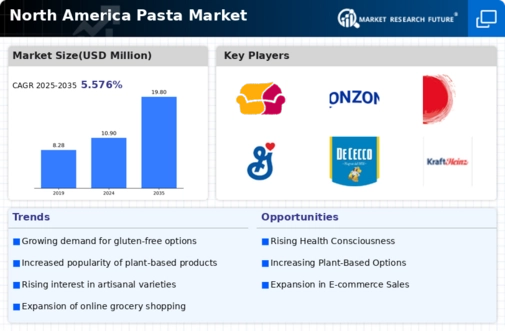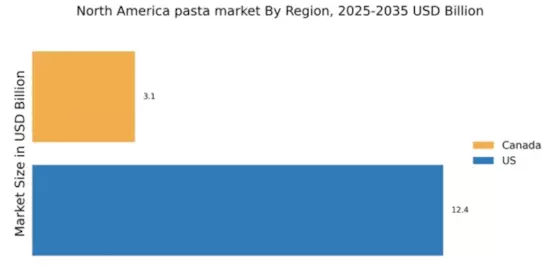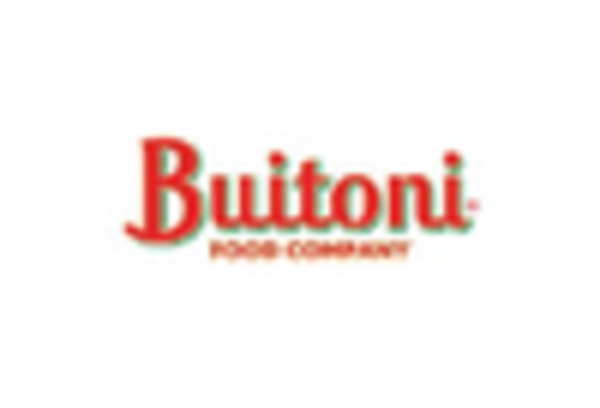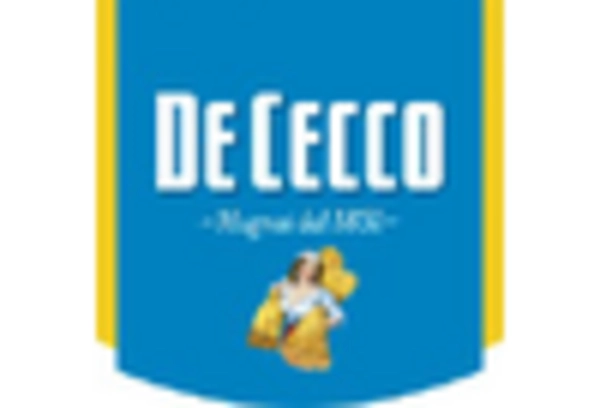Expansion of E-Commerce Channels
The rapid growth of e-commerce in North America is reshaping the distribution landscape of the pasta market. With more consumers turning to online shopping for convenience, brands are increasingly leveraging digital platforms to reach a broader audience. Recent statistics indicate that online grocery sales have surged, with e-commerce accounting for nearly 20% of total grocery sales in the region. This shift presents a significant opportunity for pasta manufacturers to enhance their visibility and accessibility. By establishing robust online presence and partnerships with major e-commerce platforms, companies can effectively cater to the changing shopping habits of consumers. Furthermore, the ability to offer subscription services and personalized recommendations may further drive customer loyalty and repeat purchases within the pasta market.
Increased Focus on Plant-Based Diets
The growing trend towards plant-based diets in North America is significantly influencing the pasta market. As more consumers adopt vegetarian and vegan lifestyles, there is a rising demand for pasta products made from plant-based ingredients. This shift is not merely a fad; it reflects a broader societal movement towards healthier eating habits and sustainability. Data indicates that the plant-based food market is expected to reach $74 billion by 2027, with pasta being a key component of this growth. Manufacturers are responding by introducing innovative products, such as lentil and chickpea pasta, which not only cater to dietary preferences but also offer higher protein content. This diversification within the pasta market is likely to attract a wider consumer base, further driving sales and market expansion.
Rising Demand for Gluten-Free Products
The increasing prevalence of gluten intolerance and celiac disease among consumers in North America has led to a notable rise in demand for gluten-free pasta options. This trend appears to be driving innovation within the pasta market, as manufacturers are developing a variety of gluten-free alternatives made from ingredients such as rice, quinoa, and lentils. According to recent data, the gluten-free segment of the pasta market is projected to grow at a CAGR of approximately 8% over the next five years. This shift not only caters to health-conscious consumers but also expands the overall market by attracting those who may not have previously considered pasta as a viable option. As a result, companies are increasingly investing in research and development to enhance the taste and texture of gluten-free products, thereby solidifying their position in the pasta market.
Innovations in Packaging and Sustainability
Sustainability concerns are becoming increasingly prominent in the North American pasta market, prompting manufacturers to explore innovative packaging solutions. As consumers become more environmentally conscious, there is a growing demand for sustainable packaging options that minimize waste and reduce carbon footprints. Recent surveys indicate that approximately 70% of consumers are willing to pay more for products with eco-friendly packaging. This trend is encouraging companies to invest in biodegradable and recyclable materials, as well as to adopt practices that promote sustainability throughout their supply chains. By aligning with consumer values, brands can enhance their reputation and appeal to a broader audience. The integration of sustainability into packaging strategies is likely to play a crucial role in shaping the future of the pasta market.
Evolving Consumer Preferences for Authenticity
In North America, there is a noticeable shift in consumer preferences towards authentic and artisanal food products, including pasta. This trend is characterized by a growing interest in traditional Italian pasta-making techniques and high-quality ingredients. Consumers are increasingly seeking products that offer a genuine culinary experience, which has prompted many brands to emphasize their heritage and production methods. The pasta market is witnessing a surge in demand for premium and specialty pasta, with sales of artisanal products rising by approximately 15% annually. This inclination towards authenticity not only enhances the perceived value of pasta but also encourages consumers to explore diverse flavors and shapes. As a result, companies are likely to invest in marketing strategies that highlight their unique offerings, thereby strengthening their position in the competitive landscape of the pasta market.


















Leave a Comment